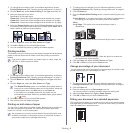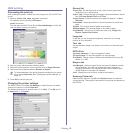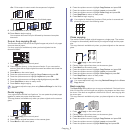
Printing_ 8
Using the shortcut icon
1. Select the PDF file you wish to print, drag and drop it to the Direct Printing
Utility shortcut icon on your desk top. The selected PDF file is sent to the
default machine.
If the default machine does not support Direct Printing Utility, the
message window alerting you to select the appropriate machine
opens. Select the appropriate machine in the Select Printer section.
2. Customize th
e machine settings for your needs.
3. Click Print.
The selected PDF file is sent to the machine.
Using the right-click menu
1. Right-click on the PDF file you wish to print and select Direct Printing
Utility.
The Direct Printing Utility window opens with the PDF file is added.
2. Select
the machine you wish to use.
3. Customize th
e machine settings for your needs.
4. Click Print.
The selected PDF file is sent to the machine.
Changing the default print settings
1. Click the Windows Start menu.
2. For Wi
ndows 2000, select Settings > Printers.
•F
or Windows XP/2003, select Printers and Faxes.
•F
or Windows 2008/Vista, select Control Panel > Hardware and Sound >
Printers.
•For Windows 7, select Control Panel > Hardware and Sound > Devices
and Printers.
•F
or Windows Server 2008 R2, select Control Panel > Hardware >
Devices and Printers.
3. Righ
t-click your machine.
4. For Wi
ndows XP/2003/2008/Vista, press Printing Preferences.
For Windows 7 and Windows Server 2008 R2, from context menus, select
th
e Printing preferences.
If Printing preferences item has ► mark, you can select other
printer drivers connected with selected printer.
5. Change the settings on each tab.
6. Click OK.
If you want to change the settings for each print job, change it in
Printing Preferences.
Setting your machine as a default machine
1. Click the Windows Start menu.
2. For Wi
ndows 2000, select Settings > Printers.
•F
or Windows XP/2003, select Printers and Faxes.
•F
or Windows 2008/Vista, select Control Panel > Hardware and Sound >
Printers.
•For
Windows 7, select Control Panel > Hardware and Sound > Devices
and Printers.
•F
or Windows Server 2008 R2, select Control Panel > Hardware >
Devices and Printers.
3. Select your machine.
4. Righ
t-click your machine and select Set as Default Printer.
For Windows 7 and Windows Server 2008 R2
If S
et as default printer item has ► mark, you can select other
printer drivers connected with selected printer.
Printing to a file (PRN)
You will sometimes need to save the print data as a file.
To create a file:
1. Check th
e Print to file box at the Print window.
2. Click Print.
3. Type
in the destination path and the file name, and then click OK.
For example c:\Temp\file name.
If you type in only the file name, the file is automatically saved in My
Documents.
Using the job accounting option
This option allows you to print with the given permission.
1. Install the driver (See "Installing USB connected machine’s driver" on
page 3 or "Installing network connected machine’s driver" on page 3).
2. Click th
e Windows Start menu.
3. For Wi
ndows 2000, select Settings > Printers.
•F
or Windows XP/2003, select Printers and Faxes.
•F
or Windows 2008/Vista, select Control Panel > Hardware and Sound >
Printers.
•For
Windows 7, select Control Panel > Hardware and Sound > Devices
and Printers.
•For Windows Server 2008 R2, select Control Panel > Hardware >
Devices and Printers.
4. Righ
t-click your machine.
5. For Wi
ndows XP/2003/2008/Vista, press Properties.
•F
or PS driver, select PS driver and right-click to open Properties.
For Windows 7 and Windows Server 2008
R2, from context menus, select
the Printer properties.
If Printer properties item has ► mark, you can select other printer
drivers connected with selected printer.
6. In printer driver properties, select Device Options.
7. Click Jo
b Accounting and select one of the options.
•Us
er permission: If you check this option, only users with user
permission can start a print job.
•Gro
up permission: If you check this option, only groups with group
permission can start a print job.


















